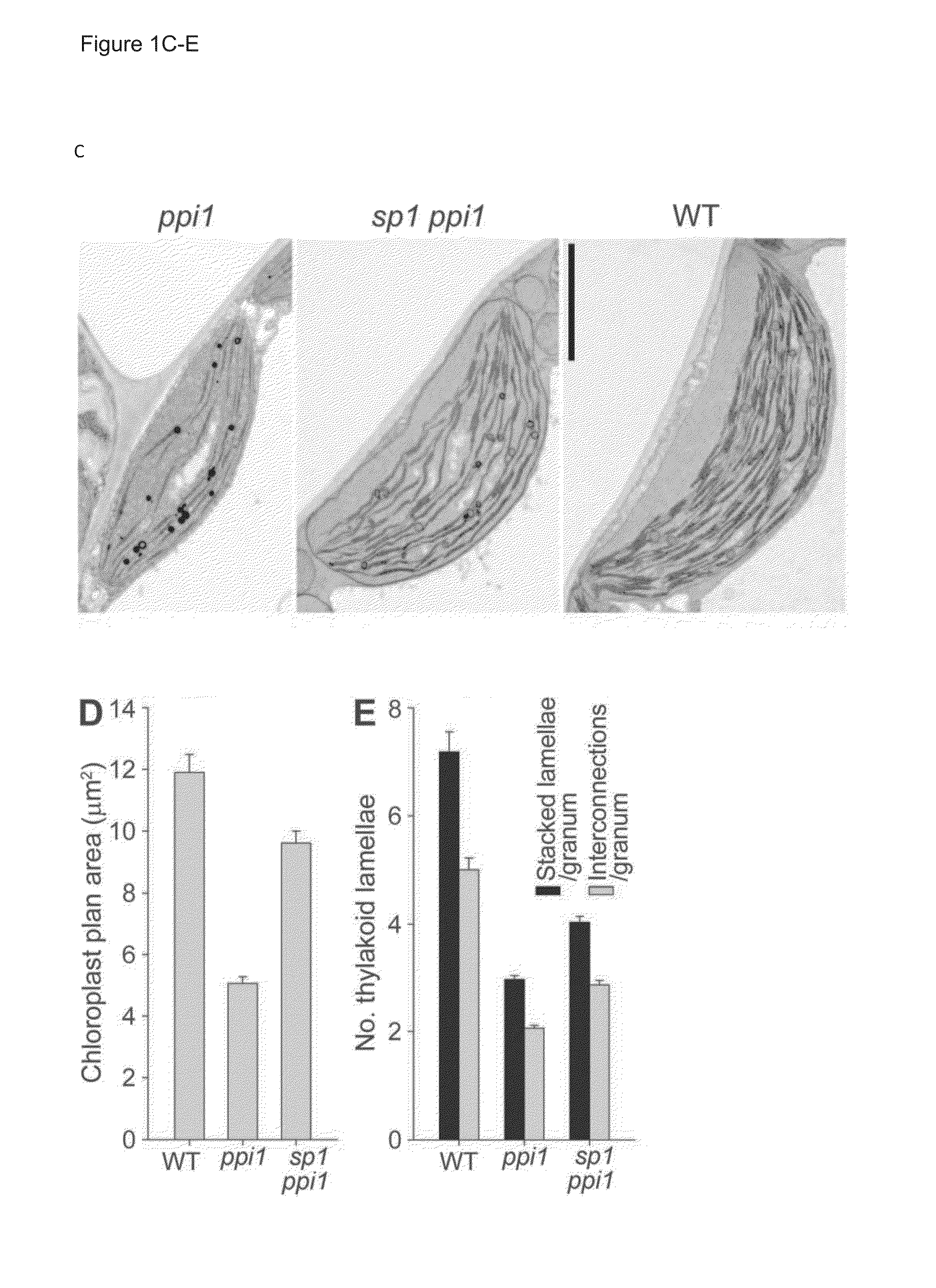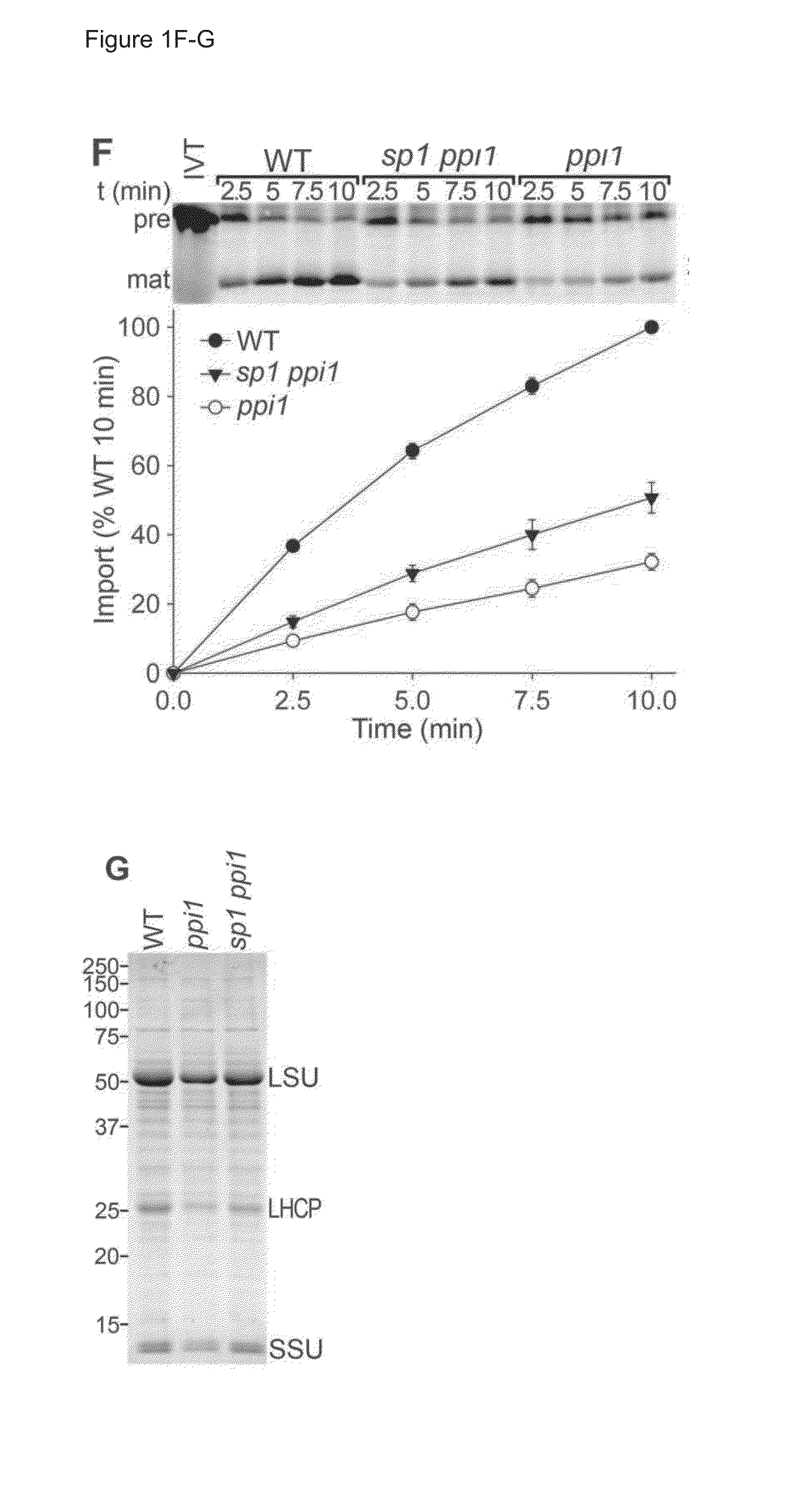Atsp1, an e3 ubiquitin ligase, and its use
- Summary
- Abstract
- Description
- Claims
- Application Information
AI Technical Summary
Benefits of technology
Problems solved by technology
Method used
Image
Examples
example 1
Characterisation of SP1 and its Role in Plastid Development
[0237]Plant Growth Conditions and Physiological Studies
[0238]With the exception of rpn8a and ppi1 introgressed into Landsberg erecta (Ler), all Arabidopsis thaliana plants were of the Columbia-0 (Col-0) ecotype. The ppi1, tic40-4, hsp93-V-1, toc75-III-3, rpn8a and pbe1 mutants have all been reported previously (7, 12, 25, 31). The sp1-2 (Salk_063571) and sp1-3 (Salk_002099) mutants were obtained from the Salk Institute Genomic Analysis Laboratory, and confirmed by genomic PCR and RT-PCR. For in vitro growth, seeds were surface sterilized, sown on Murashige-Skoog (MS) agar medium in petri plates, cold-treated at 4° C., and thereafter kept in a growth chamber. All plants were grown under a long-day cycle (16 h light, 8 h dark). Chlorophyll measurement was performed using a Konica-Minolta SPAD-502 meter, or following N,N′-dimethylformamide (DMF) extraction using a spectrophotometer (7, 12).
[0239]Dark-to-light shift experiments ...
example 2
Expression of solSP1
[0272]SP1 homologues are widely distributed in plants. To assess whether SP1's proposed role in plastid developmental transitions is conserved, we have studied the tomato SP1 orthologue, solSP1 (Solyc06g084360.1.1; 73% a.a. identity to SP1, SEQ ID No. 9), in tomato. A particular advantage of working with tomato will be the opportunity to study SP1's importance for the differentiation of carotenoid-rich chromoplasts from chloroplasts during tomato fruit ripening, which is not possible in Arabidopsis.
[0273]We have confirmed that solSP1 localizes to the plastid envelope using asolSP1-YFP fusion (made in p2GWY7) using the Nikon Eclipse TE-2000E system (as for Arabidopsis SP1) in transfected tomato leaf protoplasts. We have generated transgenic tomato plants that either silence (knockdown, KD) or overexpress (OX) solSP1. For KD, we have made two different artificial microRNA (amiRNA) constructs based on pRS300 that target different regions of the gene. Together with ...
example 3
SP1 Regulates Stress Tolerance
[0275]Regulation of stress tolerance by SP1 is shown in FIGS. 10-15. We have shown that Arabidopsis sp1 mutants do not green well following germination on saline medium (150 mM NaCl), relative to wild-type plants, whereas plants overexpressing SP1 show considerable improvements in greening under these conditions.
[0276]Similarly, Arabidopsis sp1 mutant plants do not develop under osmotic stress conditions (400 mM mannitol), whereas plants overexpressing SP1 exhibit improved development relative to the wild type under these conditions.
[0277]In response to oxidative stress (brought about by treatment with the herbicide paraquat), sp1 mutant Arabidopsis plants exhibit a higher rate of death than the wild type, whereas the SP1 overexpressor plants exhibit a significantly reduced death rate relative to wild type (i.e., the SP1 overexpressor plants display considerably improved survival under oxidative stress conditions).
[0278]Staining of seedlings exposed to ...
PUM
| Property | Measurement | Unit |
|---|---|---|
| Fraction | aaaaa | aaaaa |
| Fraction | aaaaa | aaaaa |
| Fraction | aaaaa | aaaaa |
Abstract
Description
Claims
Application Information
 Login to View More
Login to View More - R&D
- Intellectual Property
- Life Sciences
- Materials
- Tech Scout
- Unparalleled Data Quality
- Higher Quality Content
- 60% Fewer Hallucinations
Browse by: Latest US Patents, China's latest patents, Technical Efficacy Thesaurus, Application Domain, Technology Topic, Popular Technical Reports.
© 2025 PatSnap. All rights reserved.Legal|Privacy policy|Modern Slavery Act Transparency Statement|Sitemap|About US| Contact US: help@patsnap.com



